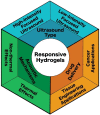Ultrasound-Induced Drug Release from Stimuli-Responsive Hydrogels
- PMID: 36135267
- PMCID: PMC9498906
- DOI: 10.3390/gels8090554
Ultrasound-Induced Drug Release from Stimuli-Responsive Hydrogels
Abstract
Stimuli-responsive hydrogel drug delivery systems are designed to release a payload when prompted by an external stimulus. These platforms have become prominent in the field of drug delivery due to their ability to provide spatial and temporal control for drug release. Among the different external triggers that have been used, ultrasound possesses several advantages: it is non-invasive, has deep tissue penetration, and can safely transmit acoustic energy to a localized area. This review summarizes the current state of understanding about ultrasound-responsive hydrogels used for drug delivery. The mechanisms of inducing payload release and activation using ultrasound are examined, along with the latest innovative formulations and hydrogel design strategies. We also report on the most recent applications leveraging ultrasound activation for both cancer treatment and tissue engineering. Finally, the future perspectives offered by ultrasound-sensitive hydrogels are discussed.
Keywords: Tissue engineering; cancer therapy; controlled drug release; drug delivery; hydrogels; polymers; smart hydrogels; stimuli-responsive; thermoresponsive materials; ultrasound.
Conflict of interest statement
The authors declare no conflict of interest.
Figures





References
-
- Manouras T., Vamvakaki M. Field responsive materials: Photo-, electro-, magnetic- and ultrasound-sensitive polymers. Polym. Chem. 2017;8:74–96. doi: 10.1039/C6PY01455K. - DOI
Publication types
Grants and funding
LinkOut - more resources
Full Text Sources

